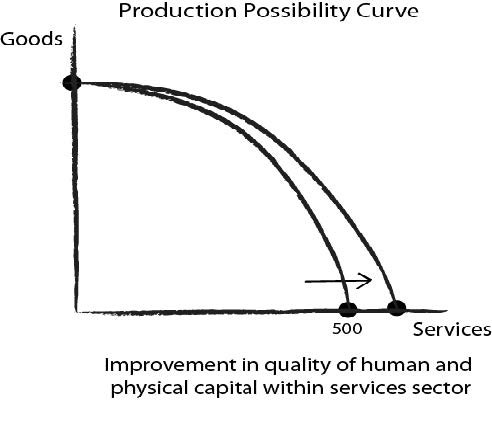Activity 6b: Aggregate supply and PPC

- An increase in productivity is likely to increase the ability of the economy to produce both goods and services which can push the PPC outwards (e.g. from point B to C). This is because an increase in productivity typically represents an improvement in the quality of resources (e.g. more productive labour). However, to the extent that the economy is operating below its productive capacity (e.g. at point A with very low levels of productivity/inefficiency), an increase in productivity can simply mean that the economy is production point moves from within the interior of the PPC (e.g. at point A) towards the boundary of the PPC (e.g. at point B).
- An increase in population growth is likely to increase the ability of the economy to produce both goods and services which once again can push the PPC outwards. This is because population growth is likely to result in a larger labour force, increasing the quantity of human capital available to producers (as well as the quality of human capital in the event of skilled immigration)and enabling the nation (or businesses) to produce more goods and services in total.
3. The PPC will shift outwards in the way shown below, highlighting that the economy is able to produce more services due to the improvement in the quality of human and physical capital.
4. When the economy produces at point A it means that it is not producing to its potential and resources are being used inefficiently. Unemployment or underemployment of resources (including labour) is likely to exist and living standards are likely to be suboptimal.
5. The economy needs to find ways of increasing the quantity of other resources apart from labour. This could involve greater exploration to find more mineral resources, investment in more capital (i.e. capital widening) or changes in government policy to open up more land for productive purposes.

6. A movement from A to B reflects an inefficient/underperforming economy using its resources better than before and therefore achieving higher levels of output. In contrast, the movement from B to C represents an efficient economy that is producing its productive capacity, finding ways to further boost capacity, such as improving/increasing the quality or quantity of resources.
7. Demand occurring at point C will reflect in excess demand for goods and services which is problematic in terms of the impact on prices (or inflation) and/or sustainable development. If the imbalance is not resolved that inflation will continue to rise which ultimately reduces competitiveness and economic growth over time.
